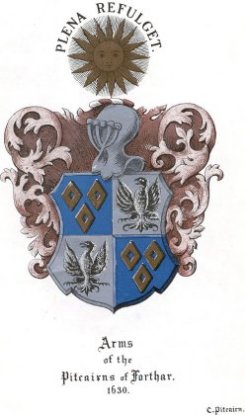|
The
Pitcairn Family People Page
We would like to us this particular page as an
open forum to all those with an interest in the Pitcairn's. To start with
we will try to include some famous Pitcairn's from history and to give you
some idea of their life stories.
On the other hand it would be far better if you
sent in stories on your own family members and we will post them hear for
all to read. Go on, make someone famous.
ARMS OF
PITCAIRN
Lord Robert Pitcairn (1520-84),
Thirteenth Laird of that Ilk and Forthar, Archdean of St Andrews,
Commendator of Dunfermline, Royal Legate, Secretary of State to King James
VI and Ambassador to Queen Elizabeth of England. His burial place and
monument is at the east end of the north wall, inside the Nave of the
Abbey, his armorial coat of arms is still distinct and an epitaph written
in Latin is translated thus:
‘Here
lies in a plain urn, the hero Robert Pitcairn the hope and pillar of his
country whom virtue, gravity worthy of a virtuous heart, and fidelity,
with sincere piety adorn. After various changes of life he now, with the
mass of his body left behind, proceeds in spirit to the Elysian Grove. He
died in the year 1584 on 18th October aged 64.’
Robert
Pitcairn had a proud and honourable lineage, documented in Scotland to the
early 13th century. The
Pitcairn arms show that it was most likely a second son of the Advocate of
Bolougne, a very eminent and powerful Flemish family, who was the first
Pitcairn to arrive in Scotland. This was during the reign of David I in
the early part of the 12th century and his role was probably to
help establish law with the introduction of the feudal system and to set
up a Scottish coinage. Robert Pitcairn’s great-grandfather, Henry
Pitcairn, married Elizabeth Ramsay, a wealthy heiress, and from then that
particular branch of Pitcairn arms were quartered with the Ramsay arms.
Robert Pitcairn, born in 1520, was the second son.
He was groomed from a very young age for a life of service to the
church and while still a young man, became Archdean of St Andrews, a most
important appointment in those days.
It is very likely that the uprisings, murders and martyrdom that
occurred in St Andrews at this time convinced Robert to side with the
Reformers.
Robert’s
uncle, George Durie, the last Abbot of Dunfermline, fled to France for a
short time in 1560 during the troubles of the Reformation,
“The monasteries were dissolved by Parliament in 1560, and therefore when
Robert Pitcairn was made Commendator the jurisdiction or power of
regality, along with the lands of the monastery, devolved upon him; thus
he obtained a right to its lands and rents, which he held until his death
in 1584” (Chalmers Gazetteer 1842). Robert Pitcairn (styled Abbot as
a mark of respect) owned and lived in his official residence, Abbot House.
The Pitcairn/Ramsay arms, can be seen on the south side of Abbot
House.
Robert was now middle-aged and caught in the maelstrom of Scottish
Politics during one of the most unsettled periods of Scottish History.
After
Mary’s Queen of Scots surrender at Carberry Hill, Robert was appointed a
Lord of the Articles in 1567 and in this capacity was present at the
Coronation of her son, King James VI age one, at Stirling.
Robert’s name stands first in a list of 15 Abbots on the Rolls of
Parliament in 1567, when the Reformed Church was legally recognised as the
National Church of Scotland. In
June 1568 Robert was appointed an Ordinary Lord of Session, then in
September 1568 he was made an Extraordinary Lord of Session.
Robert also acted, as Scottish Ambassador to Queen Elizabeth I
while Queen Mary was held captive in London.
Regents were appointed to look after the Scottish Kingdom until her
son James VI was old enough to rule; during this period Robert survived
the Regencies of Murray, Lennox, Marr and Morton.
Robert
Pitcairn married Euphemia Murray in 1577, she was the daughter of Sir
William Murray, one of the joint governors of James VI and sister to James
Murray of Perdewis who was known to own a house on the south side of
Maygate probably near Abbot House. Most import people had a town house near or around the area
of the Abbey and by 1580 Robert had extended and improved Abbot house
where he conducted his considerable official business.
The quaint inscription on an old advice stone was placed over the
principle entrance to the house most likely at the time by Robert
Pitcairn.
He
also owned a substantial Manor House in Limekilns where his new
Pitcairn/Murray arms would have been placed, these arms were moved, but
can still be seen carved on a building in Limekilns call the old vault.
Robert owned Limekilns, the orchard, the harbour and looked after
the “Kings cellar” there.
In
1582 Robert Pitcairn along with the most loyal nobles invited the King to
Ruthven Castle, where he was detained, because of his involvement Robert
was held captive in Loch Leven Castle for five months then he was freed
with a caution to stay in
Dunfermline or six mile around under pain of £10.000.
Robert and his wife fled to England and then to Flanders during the
winter of 1583-4. He returned
to Limekilns moving later to his house in the Maygate to be near his
medical attendant and this is where he died on the 18th October
1584.
|


